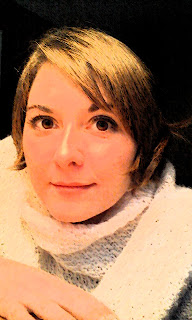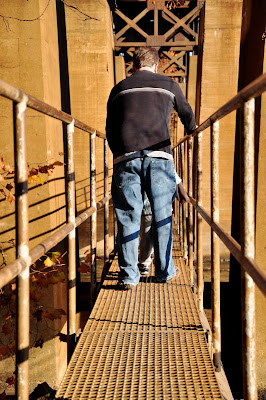Instead of taking a class, I'm going to teach myself PhotoShop, using my own images and document them here daily.
Tuesday, January 31, 2012
Monday, January 30, 2012
26. Fixing an Underexposed Photograph
Tonight, I learned how to easily adjust your underexposed photo by duplicating the layer and changing the blend mode from normal to screen until it's just right. The problem with this photo is that in then leaves the other hand overexposed. I have some digital dodging and burning to learn.......
before:
Tuesday, January 24, 2012
24.Creating Planets
This would have made a nice snow globe for my last project, but I just wan't ready to tackle Photoshop yet. Using this tutorial, I made the image the same size as the original height, flipped the image, and distorted with the polar coordinates filter.
Here is the Burnside Bridge Willamette River in Portland Oregon:
Monday, January 23, 2012
23. Filter Experiment
Here is the self portrait I took today for a Richmond Photography Meetup monthly challenge. I tried lots of different artistic filters. This is what they did:
 |
| Original |
 |
| Emboss at 90 degrees |
 |
| Diffused Glow |
 |
| Dark Strokes |
 |
| Plaster |
 |
| Patchwork |
Sunday, January 22, 2012
Saturday, January 21, 2012
21. Changing Eye Color
This tutorial was much easier than I thought. So easy I should probably work on another image, or at least start on tomorrow's project, but I'm not.
Here, I turned my baby's brown eyes blue.
for a more natural blue I could have done two things:
1. chosen a less striking blue hue
2. adjusted the opacity (here it is at 58%)
but I wasn't going for natural;)
Friday, January 20, 2012
20. Creating a Fanta Inspired Image
I used this tutorial to create the following image. It may not be Fanta, but close enough.
Here is the original:
Thursday, January 19, 2012
19. Creating See-Through Ghost Photos
This project gave me a lot of practice with the cloning stamp, diffused light and erasing. The hard part was finding photos that didn't have people smiling (my personal preference, since a smiling ghost seems even creepier) and a background that isn't too difficult to clone out.
Here is the photo of my daughter I started with:
Ghostlike:
18. Clone Stamp
Fascinated by the paranormal and often trying to create "spooky" in my images, either with crime scenes or mirrors, I was drawn to a tutorial that helps you create a ghost-like image.
I found that using the clone tool alone is an important lesson, so actually creating the ghost will be featured on day 19:)
Here is the original of my husband and son walking the pipeline bridge in Richmond, VA.
Here is the image after removing the subjects and cloning the surrounding areas:
Monday, January 16, 2012
16. Zoom and Motion Effect
This tutorial is pretty easy and the effect pretty striking. It could definitely use more tweaking and feathering, but I'm tired. I am glad I learned this for later use.
15. Canvas Texture Imitation
I used this tutorial to create a canvas texture. The first photo I used was black and white, and the effect wasn't as noticeable, so I got more practice and tried it again with this photo:
Sunday, January 15, 2012
14. Sharpening, Watercolor with Saturation Boost
I'm behind posting because I currently have three projects going, none of which I can completely get through. I keep getting hung up on certain steps. I will either revisit the projects later once I know more about Photoshop or muddle through, depending on my patience level.
For now I worked with a photo taken at Poe's 203rd birthday bash which I was happy with compositionally, but it was not quite sharp in focus, so I took the following liberties with it.
before:
after:
toned down:
Friday, January 13, 2012
12. Neon Glow
I used this tutorial (#3) to create a neon glow. Here is the image before the effect:
with the glow:
11. Filter the Background
I used this tutorial (#2) and had fun experimenting with different filters, and found the watercolor filter a good fit.
 |
| Original photo taken at University of Richmond |
 |
| Watercolor filter, main subject untouched. |
Another photo from that day at the music festival that I can't resist sharing.
Tuesday, January 10, 2012
10. Classic Solarisation Photo Effect in Photoshop
"Solarisation has been used since the very beginning of photography but was made famouse by Man Ray when he rediscovered the technique by accident in the 1930′s. The effect consists mainly of partially reversed tones in an image recorded on a negative or a photographic print. Basically the dark areas appear light or the light areas appear dark. The effect was usually caused by accidentally exposing an exposed plate or film to light during developing. That said, results were usually unpredictable and good results were obtained by luck and lots of practice. In this tutorial, I’m going to show you a simple way of getting similar results in Photoshop without having to lock yourself in the darkroom!"
-Photoshop Road Map
I tried a few photos out for this and none of them really "did" it for me. Here is the before picture of a paper mache skull I used before decorating it here:
here it is with solarisation:
Monday, January 9, 2012
9. Simple Orton Effect for Dreamy Soft Focus Images
"In this tutorial I’m going to show you how I generally apply a soft focus trick known as the Orton Effect after it’s creator photographer Michael Orton. In the film days, this effect was achieved by overlaying two or more images of an identical scene with different exposures and focus on slide film. To do this, you had to use a tripod so your images would align perfectly.

Nowadays, you can achieve the same results with just a single image using Photoshop. This technique will add a vintage dream like feel to your images very suitable for portraits, weddings, landscapes and children photography."
I used this image I took of a sunset in Fishing Bay, VA:

7. Turning an Image Black and White
I followed this tutorial about turning my image black and white.
"Back in the day, when one would print their own black and white prints, you had a choice of a zillion different papers. They basically boiled down to cooltone and warmtone papers. This combined with different developers gave one an array of tones to choose from for any given picture. Sadly, nowadays it’s getting harder to find specific papers and certain developers are no longer being manufactured. In the digital era, most people who might not have gone through the trouble of trying different tones of paper (or even B&W printing for that matter) will be satisfied with converting a color image to a straight B&W palette by simply desaturating the color. Today we’re going to take it a step further. Achieving different tones for specific images will help you create different moods according to the overall look you’re going for." -Photoshop Road Map
"Back in the day, when one would print their own black and white prints, you had a choice of a zillion different papers. They basically boiled down to cooltone and warmtone papers. This combined with different developers gave one an array of tones to choose from for any given picture. Sadly, nowadays it’s getting harder to find specific papers and certain developers are no longer being manufactured. In the digital era, most people who might not have gone through the trouble of trying different tones of paper (or even B&W printing for that matter) will be satisfied with converting a color image to a straight B&W palette by simply desaturating the color. Today we’re going to take it a step further. Achieving different tones for specific images will help you create different moods according to the overall look you’re going for." -Photoshop Road Map
Subscribe to:
Posts (Atom)








































